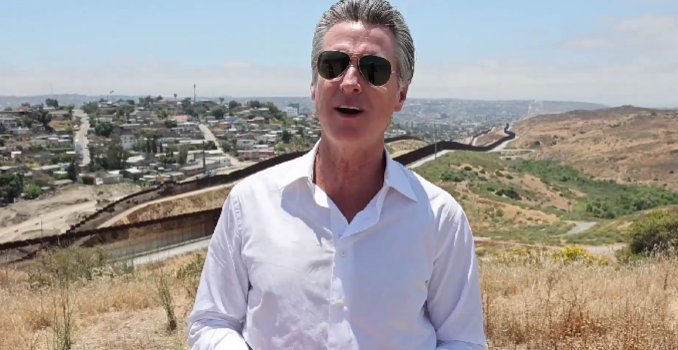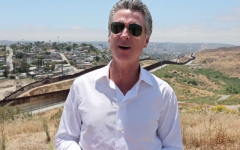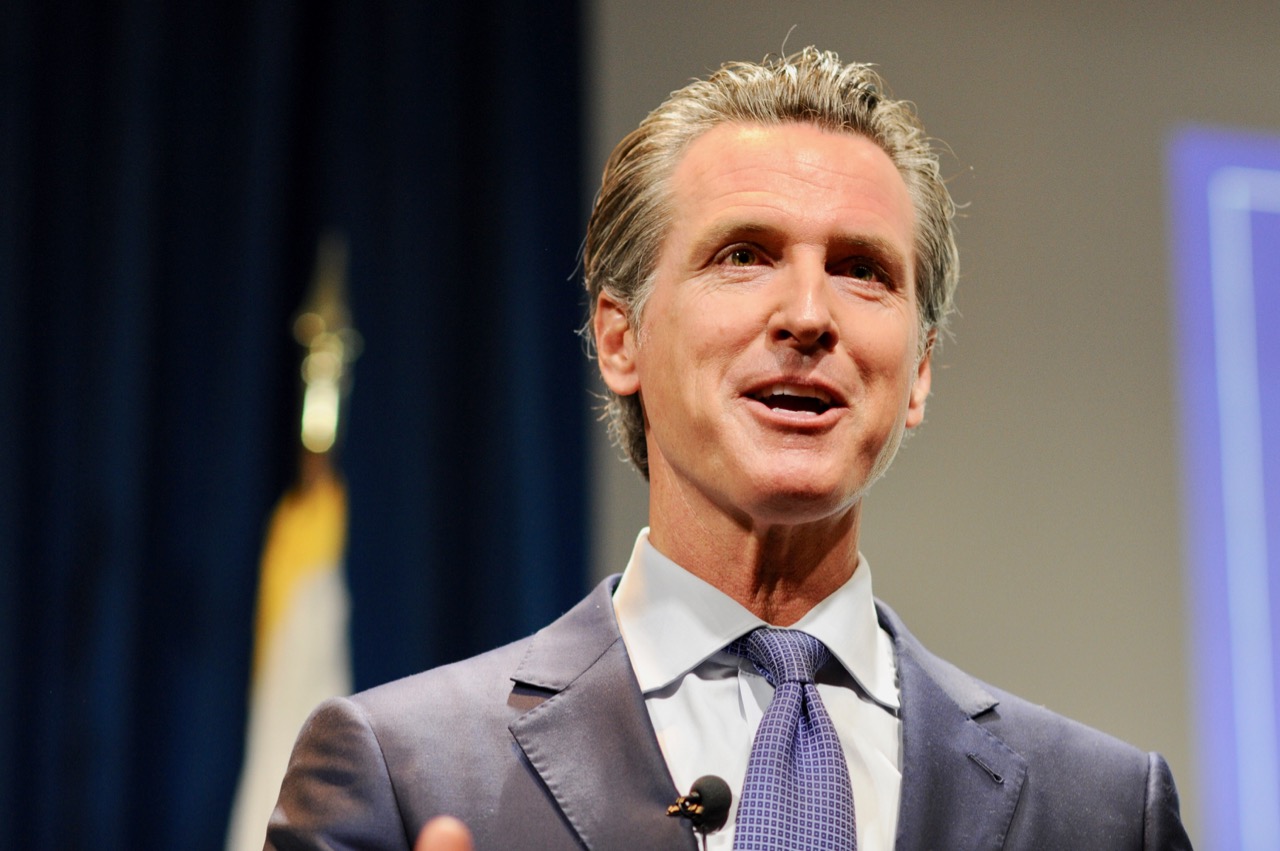
Governor Gavin Newsom at the San Ysidro border crossing on June 13, 2024 (Photo: California Office of the Governor video)
California National Guard Counterdrug Task Force Seizes nearly $4 Million Worth Of Fentanyl In June Following Ramping Up Of Actions
Seizures come amidst a more than doubling of CalGuard Task Force troops
By Evan Symon, July 24, 2024 5:11 pm
Governor Gavin Newsom announced on Wednesday that the California National Guard’s (Cal Guard) Counterdrug Task Force helped seize 1,068,219 fentanyl pills and 423 pounds of fentanyl powder in June, building off of a doubling employment of Cal Guard troops in the Task Force last month.
California is hard at work getting fentanyl off our streets.
Just last month, our @TheCalGuard counterdrug task force helped seize one million fentanyl pills and hundreds of pounds of fentanyl powder from communities across the state.
Read the thread 🧵 (1/3) pic.twitter.com/hPYK0PxjxE
— California Governor (@CAgovernor) July 24, 2024
In the past few years, Newsom has deployed more and more CalGuard troops into fighting against drugs coming into and being sold in California. Last year, Newsom directed CalGuard to be a part of a multi-agency operation in San Francisco to help local authorities fight against the trafficking and sale of fentanyl in the city. By December of 2023, the multi-agency operation, with CalGuard’s help, began to show significant progress in the seizure of fentanyl and other drugs. The operations CalGuard supported statewide resulted in the record seizure of 62,224 pounds of fentanyl in 2023, a 1066% increase since 2021.
At the same time, Newsom put more resources into CalGuard’s Counterdrug Task Force. In a May announcement, CalGuard said that, in March 2024 alone, the Counterdrug Task Force, with the help of state, local and federal partners, helped seize over 5,000 pounds of fentanyl and nearly 1.3 million fentanyl pills. Also in the announcement, they revealed that the taskforce had helped other agencies seize 7,100 pounds of fentanyl and more than 3.4 million fentanyl pills across California, including at ports of entry along the border.
Despite this, fentanyl smuggling continued. This led to Governor Newsom more than doubling the number of CalGuard troops being deployed across the state and at the border, from 155 members to 392, last month. In a statement, he said that his goal was to further crack down on the smuggling of illegal drugs like Fentanyl into the state.
“We are doubling the number of CalGuard members deployed to crack down on fentanyl smuggling,” said Newsom on X last month. “This work will help take down transnational organizations & the illegal drugs they attempt to bring into our state—holding smugglers accountable & taking deadly drugs off our streets.”
While CalGuard was praised for their increased actions, Newsom was criticized for not doing more directly at the border and for spreading troops thin. Nonetheless, the Calguard expansion went forward. This led to the release of the results from June on Wednesday. According to CalGuard, the Task Force seized 1,068,219 fentanyl pills and 423 pounds of fentanyl powder in June. In total, the street value was estimated to be around $3,875,355.
🧵 (3/3) pic.twitter.com/7kCvTxAFY4
— California Governor (@CAgovernor) July 24, 2024
“We’re doubling down on our work to tackle the opioid and fentanyl crisis,” explained Newsom on Wednesday. “California is hard at work getting illegal fentanyl off our streets, intercepting the drug at our border, and holding traffickers accountable. Just last month, our Counterdrug Task Force helped seize one million deadly fentanyl pills and hundreds of pounds of fentanyl powder from communities across the state.”
Drug seizure experts told the Globe on Wednesday that Newsom and CalGuard were on the right track, but needed a harder look at smuggling operations at the border, especially in San Diego County.
“Nobody complained about more National Guard troops joining in the effort,” added Randy Chavez, a former narcotics detective who helped coordinate with state and federal agencies for seizures on multiple occasions, to the Globe on Wednesday. “The big complaint was where they went afterwards. Customs and Border Patrol need that extra assistance, but not just at border crossings. They need to be along the border, as well as helping out along the beaches in San Diego County.”
“The fentanyl situation is as bad as ever, so things need to be more tactical. And $4 million in seizures. That is great. But that needs to go up. Smugglers and dealers on up need to be prosecuted more, and other agencies need to get involved. It all can’t fall on the Task Force for this. It is one part in fighting this. Everyone needs to being hardball on this if we want to start chipping away at the issue. That’s how it works. The Task Force is doing great, but they need everyone to be getting that bump in support too.”
July’s figures, the first full month with the expanded deployment, are due to come in next month.
- Bill to Require Law Enforcement Disclosure if AI Was Used To Help Write Reports - August 7, 2025
- Gov. Newsom Files FOIA Request To ‘Expose True Cost’ Of L.A. Federal Troop Deployment for Anti-ICE Riots - August 6, 2025
- California Redistricting: How Newsom’s Plan Will Demolish Hard Fought GOP Gains - August 6, 2025





… Meanwhile, too many ‘sober’ people still erroneously perceive drug addicts as simply being weak-willed and/or having committed a moral crime.
Yes, international and domestic merchants of the drug-abuse/addiction scourge must be targeted for long-overdue political action and criminal justice. But western pharmaceutical corporations have intentionally pushed their own very addictive and profitable opiate resulting in immense suffering and overdose death numbers — indeed the real moral crime — yet got off relatively lightly and only through civil litigation.
Also, neglecting and therefor failing people struggling with debilitating addiction should not be an acceptable or preferable political, economic or religious/morality option. But the more callous politics and politicians that are typically involved with lacking addiction funding/services tend to reflect conservative electorate and representatives’ opposition, however irrational, against making proper treatment available to low- and no-income addicts.
Typically societally overlooked is that intense addiction usually doesn’t originate from a bout of boredom, where a person consumed recreationally but became heavily hooked on a self-medicating substance that eventually destroyed their life and even those of loved-ones.
More accurately: the greater the drug-induced euphoria or escape one attains from its use, the more one wants to repeat the experience; and the more intolerable one finds their sober reality, the more pleasurable that escape will likely be perceived. In other words: the greater one’s mental pain or trauma while sober, the greater the need for escape from reality, thus the more addictive the euphoric escape-form will likely be. ….
Especially when the substance abuse is due to past formidable mental trauma, the lasting solitarily-suffered turmoil can readily make each day an ordeal unless the mind is medicated. …
Albeit with sympathy, I also used to look down on those who had ‘allowed’ themselves to become addicted. Yet I myself have suffered enough unrelenting PTSD symptoms to have known, enjoyed and appreciated the great release upon consuming alcohol and/or THC.
Yes, international and domestic merchants of the drug-abuse/addiction scourge must be targeted for long-overdue political action and criminal justice. But western pharmaceutical corporations have intentionally pushed their own very addictive and profitable opiate resulting in immense suffering and overdose death numbers yet got off relatively lightly and only through civil litigation.
Though sympathetic, I used to look down on those who had ‘allowed’ themselves to become heavily addicted. Yet I myself have suffered enough unrelenting PTSD symptoms to have known, enjoyed and appreciated the great release upon consuming alcohol and/or THC.
Typically societally overlooked is that intense addiction usually doesn’t originate from a bout of boredom, where a person consumed recreationally but became heavily hooked on a self-medicating substance that eventually destroyed their life and even those of loved-ones.
More accurately: the greater the drug-induced euphoria or escape one attains from its use, the more one wants to repeat the experience; and the more intolerable one finds their sober reality, the more pleasurable that escape will likely be perceived. In other words: the greater one’s mental pain or trauma while sober, the greater the need for escape from reality, thus the more addictive the euphoric escape-form will likely be.
Especially when the substance abuse is due to past formidable mental trauma, the lasting solitarily-suffered turmoil can readily make each day an ordeal unless the mind is medicated.
Meantime, neglecting and therefor failing people struggling with debilitating addiction should not be an acceptable or preferable political, economic or religious/morality option. But the more callous politics and politicians that are typically involved with lacking addiction funding/services tend to reflect conservative electorate and representatives’ opposition, however irrational, against making proper treatment available to low- and no-income addicts.